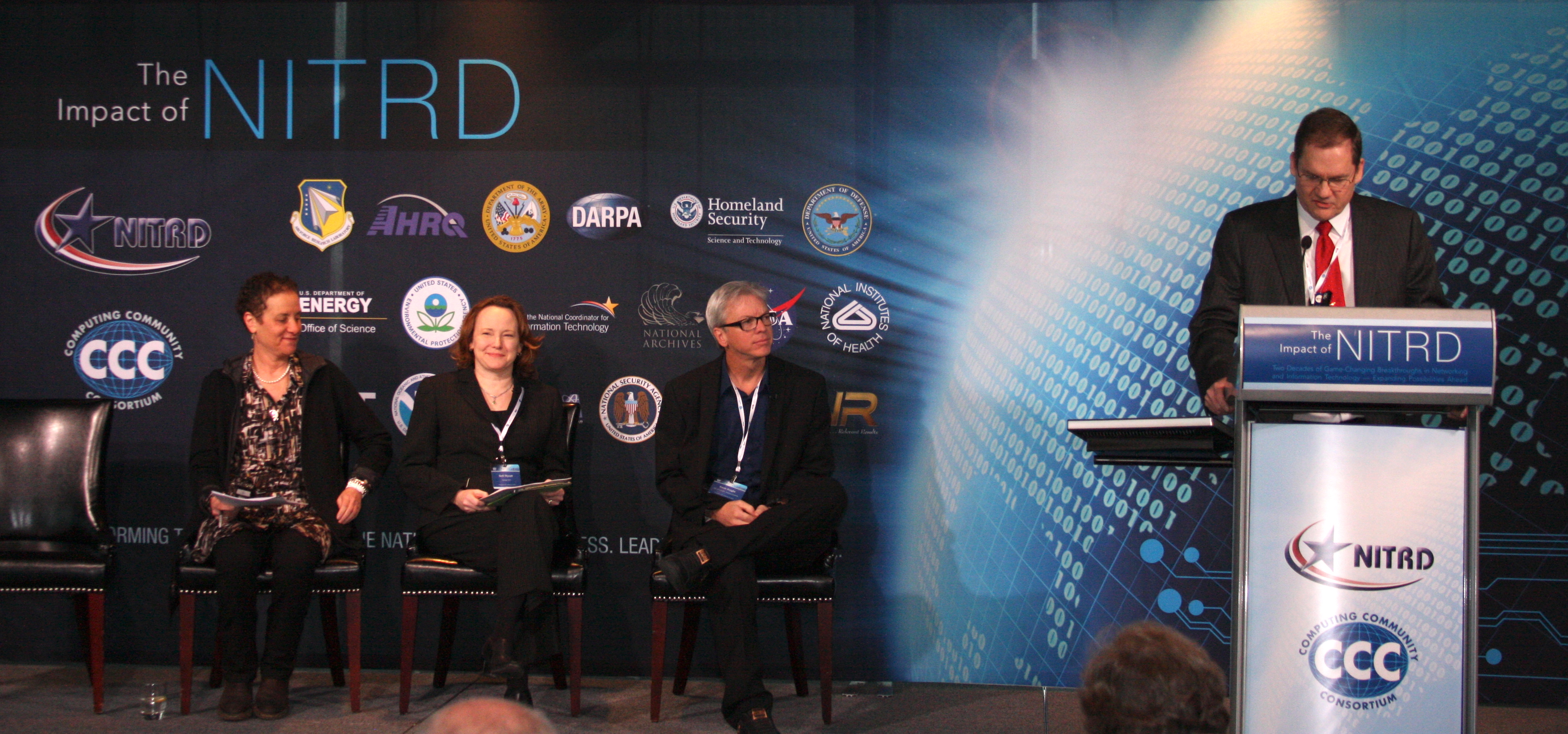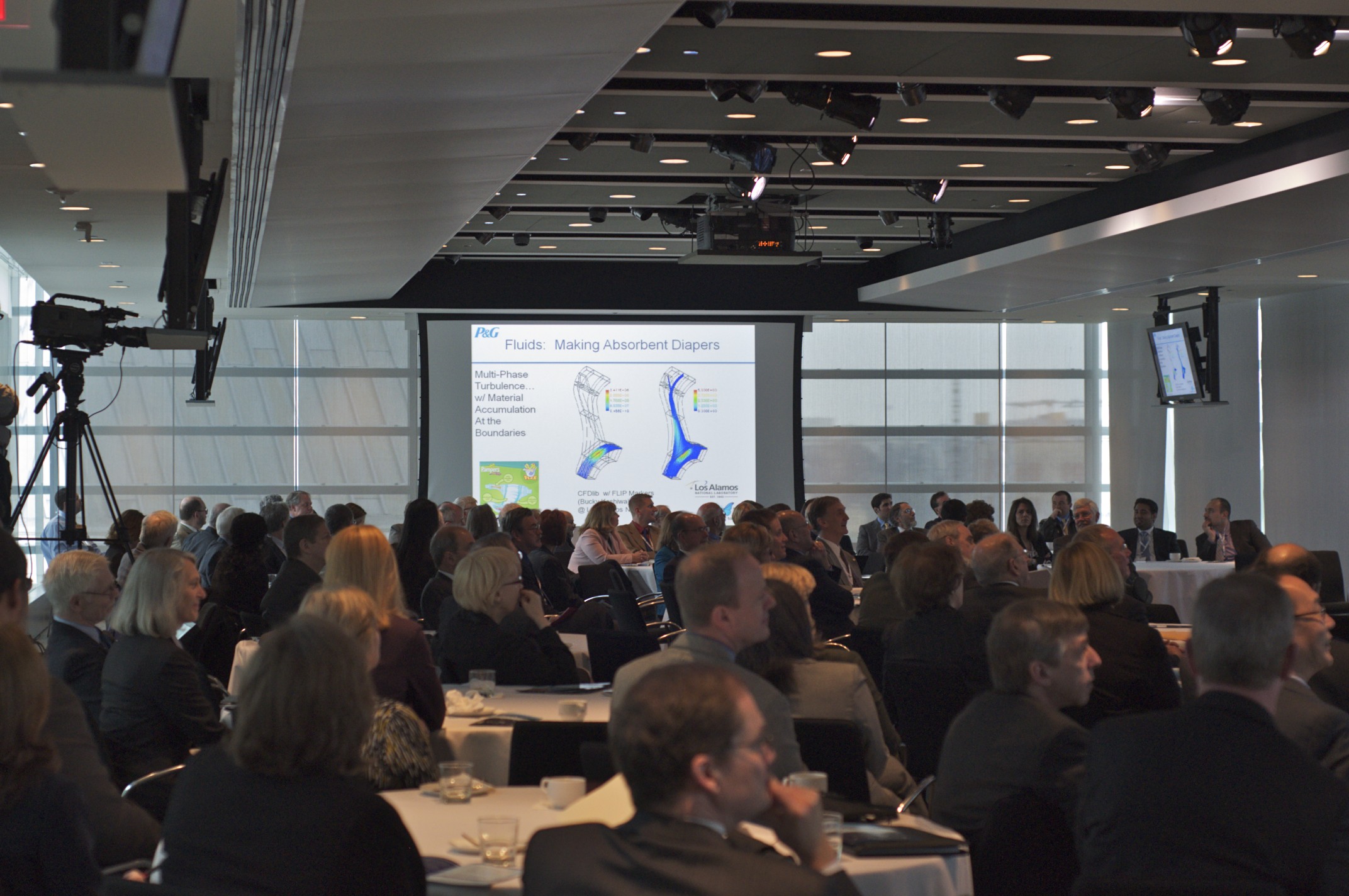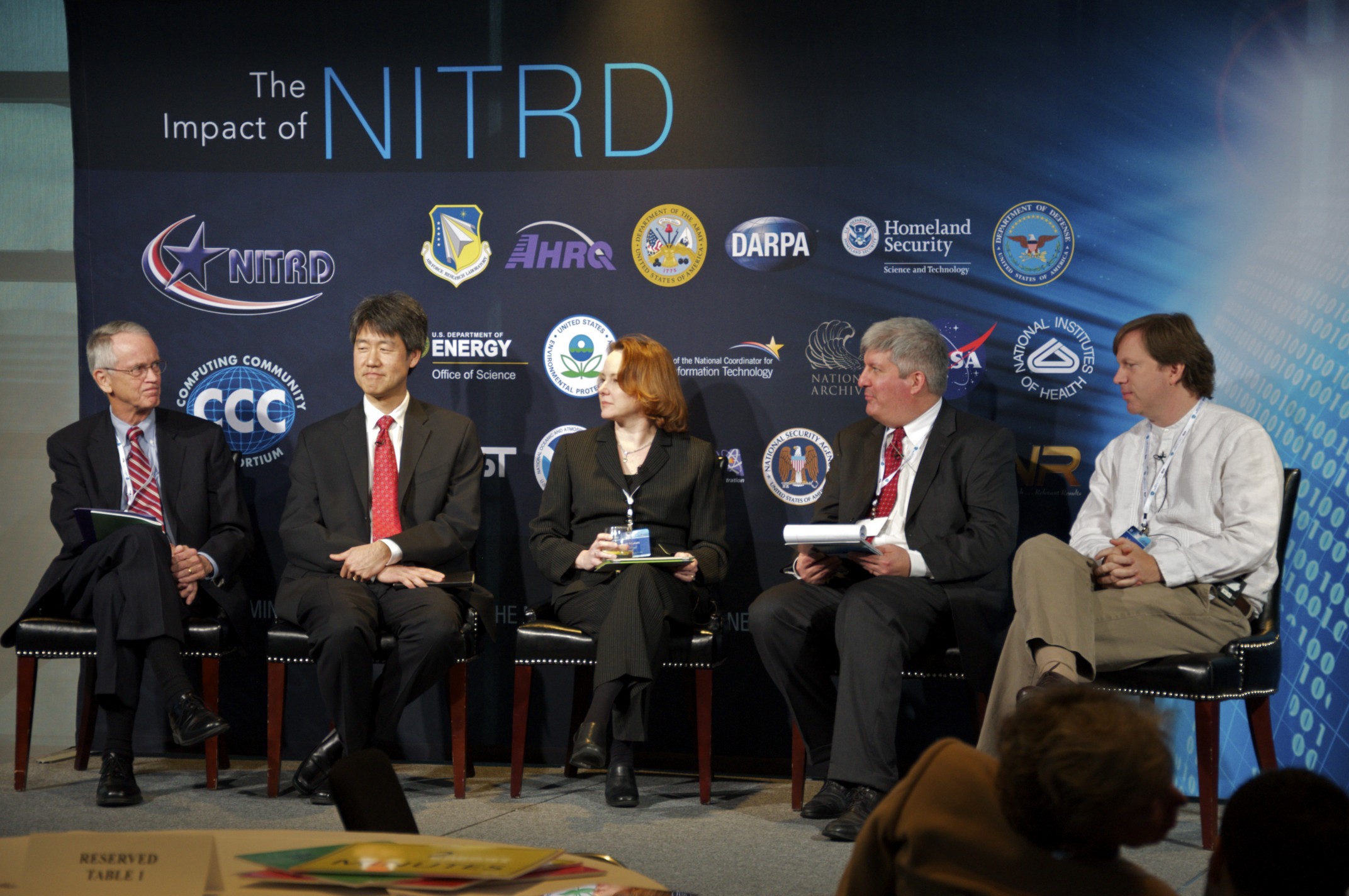 On Feb. 16th, over 150 Federal officials, Congressional staffers, academic researchers, and industry leaders packed a room overlooking the United States Capitol to mark two decades of coordinated Federal investment in networking and information technology research and development with a daylong symposium exploring progress and prospects in the field.
On Feb. 16th, over 150 Federal officials, Congressional staffers, academic researchers, and industry leaders packed a room overlooking the United States Capitol to mark two decades of coordinated Federal investment in networking and information technology research and development with a daylong symposium exploring progress and prospects in the field.
Today, I’m delighted to announce that we are launching a new website with complete materials from this extraordinary day — including videos, photos, slides, and written summaries from the 19 15-minute presentations by leaders of the field, plus a luncheon keynote by former Vice President Al Gore, a longtime champion of information technology R&D, and special remarks by former Congressman Tom Davis (R-Va.), also a champion of our nation’s investments in fundamental R&D. Please check it out here — and please help us disseminate this resource by forwarding it on to your colleagues, graduate and undergraduate students, and friends.
 Organized by the Computing Community Consortium (CCC), in consultation with the National Coordination Office for Networking and Information Technology Research and Development (NCO/NITRD), the symposium — titled “The Impact of NITRD: Two Decades of Game-Changing Breakthroughs in Networking and Information Technology — Expanding Possibilities Ahead” — marked 20 years of the Federal Government’s NITRD Program. Chartered by Congress under the High-Performance Computing Act of 1991 — legislation sponsored by then-Senator Gore — as well as the Next Generation Internet Research Act of 1998 and the America COMPETES Act of 2007, the NITRD Program is the oldest and largest of the small number of formal Federal programs that engage multiple agencies. Originally comprising 8 agencies, today it provides a framework and mechanisms for coordination among 15 Federal agencies that support networking and information technology research and development. In particular, the program facilitates cooperation and coordination across a broad landscape, enabling these agencies to tackle the inherently multidisciplinary, multitechnology, and multisector challenges of today’s R&D horizons. The Program’s success in collaboration has come to be viewed as a model Federal R&D effort that leverages agencies’ strengths and avoids duplication.
Organized by the Computing Community Consortium (CCC), in consultation with the National Coordination Office for Networking and Information Technology Research and Development (NCO/NITRD), the symposium — titled “The Impact of NITRD: Two Decades of Game-Changing Breakthroughs in Networking and Information Technology — Expanding Possibilities Ahead” — marked 20 years of the Federal Government’s NITRD Program. Chartered by Congress under the High-Performance Computing Act of 1991 — legislation sponsored by then-Senator Gore — as well as the Next Generation Internet Research Act of 1998 and the America COMPETES Act of 2007, the NITRD Program is the oldest and largest of the small number of formal Federal programs that engage multiple agencies. Originally comprising 8 agencies, today it provides a framework and mechanisms for coordination among 15 Federal agencies that support networking and information technology research and development. In particular, the program facilitates cooperation and coordination across a broad landscape, enabling these agencies to tackle the inherently multidisciplinary, multitechnology, and multisector challenges of today’s R&D horizons. The Program’s success in collaboration has come to be viewed as a model Federal R&D effort that leverages agencies’ strengths and avoids duplication.
 The current co-chairs of the multiagency NITRD Subcommittee to the National Science and Technology Council’s (NSTC) Committee on Technology — George Strawn, the director of the National Coordination Office for NITRD, and Farnam Jahanian, Assistant Director for Computer and Information Science and Engineering at the National Science Foundation — kicked off the day. Jahanian described the information technology discovery and innovation ecosystem, emphasizing how advances in networking and information technology are the result of a complex public-private partnership spanning academia, industry, and government; how these investments have returned exceptional dividends to the nation; and how we need to constantly replenish the wellspring of new ideas and train new talent.
The current co-chairs of the multiagency NITRD Subcommittee to the National Science and Technology Council’s (NSTC) Committee on Technology — George Strawn, the director of the National Coordination Office for NITRD, and Farnam Jahanian, Assistant Director for Computer and Information Science and Engineering at the National Science Foundation — kicked off the day. Jahanian described the information technology discovery and innovation ecosystem, emphasizing how advances in networking and information technology are the result of a complex public-private partnership spanning academia, industry, and government; how these investments have returned exceptional dividends to the nation; and how we need to constantly replenish the wellspring of new ideas and train new talent.
Jahanian, together with Jeannette Wing, President’s Professor of Computer Science and head of the computer science department at Carnegie Mellon University, helped set the stage for the day. Wing stepped through “A Day in the Life,” providing 20-year contrasts in a typical person’s day, from when one wakes up in the morning (20 years ago, we used to brush our teeth the moment we awoke, but today we first check our e-mail) to when one goes to sleep (back then, we used to read books, but today we read and play games on our iPads and Kindles). She remarked how Chrome, Firefox, and Internet Explorer did not exist 20 years ago; Amazon, Facebook, Google, Netflix, Skype, Twitter, and YouTube did not exist; and how even Android, Blackberry, iPod, iPhone, iPad, and Kindle did not exist.
“Imagine your life without them!” Wing said.
The day then featured an excellent collection of 15-minute technical presentations describing both the progress and promise of the field. Among the speakers (in order of appearance): Kevin Knight; Elizabeth Mynatt; Helen Nissenbaum; Sebastian Thrun; Shwetak Patel; Erik Brynjolfsson; Tom Lange; Vint Cerf; William Scherlis; Stefan Savage; Russ Altman; David Keyes; Katherine Yelick; Eric Brown; Eric Horvitz; and Alexander Szalay. The audience — which included a large number of viewers to a live web stream — heard from these experts about human language technology; autonomous vehicles; sensing; privacy; security; software; scientific discovery; data-driven approaches to health, to science, and to reasoning; and so on. And it learned that advances in computer science have an extremely broad role. In medicine, for example, that role includes not just electronic health records, but also evidence-based medicine, automated diagnosis, and the complete instrumentation of the body. In energy and sustainability, that role includes not just high-performance computing as utilized by the Department of Energy’s Office of Science, but also sensors in homes for energy management: smart homes and smart offices as the leaf notes of the smart grid, a focus of DoE’s Office of Energy Efficiency and Renewable Energy (EERE). And in transportation, the audience took in not just the promise of widespread use of autonomous vehicles in the years ahead, but also how society is already benefiting from capabilities such as adaptive cruise control, anti-lock brakes, and automated stay-in-lane systems that can increase the utilization of existing highways, and continued advances in logistics that allow companies such as Zipcar to increase the utilization of vehicles, better amortizing the economic and environmental costs of their production.
Former Vice President Gore described the discussions that led to the High-Performance Computing Act of 1991; the role of the National Coordination Office and the President’s Information Technology Advisory Committee (PITAC) in helping to shape the executive branch agency investments in research and development in the networking and IT sector; and the essential role of the program in driving the nation’s competitiveness. And he emphasized the role of technology in democracy and civic discourse. The good news: the Internet has shown its power to facilitate disruptive change around the globe. The bad news: in many nations, including our own, the role of the Internet in lowering the barrier-to-entry to the public square where discourse takes place has just begun. There is a great deal more that must be accomplished.
 The symposium concluded with a panel led by Tom Kalil, Deputy Director for Policy for the White House Office of Science and Technology Policy (OSTP), discussing how to encourage truly ground-breaking research. The panelists included Mynatt, Savage, Charles Vest (National Academy of Engineering), and Peter Lee (Microsoft Research).
The symposium concluded with a panel led by Tom Kalil, Deputy Director for Policy for the White House Office of Science and Technology Policy (OSTP), discussing how to encourage truly ground-breaking research. The panelists included Mynatt, Savage, Charles Vest (National Academy of Engineering), and Peter Lee (Microsoft Research).
Following the symposium, many of the current NITRD agencies participated in an evening reception and showcase event, at which they presented flyers, posters, and/or small demonstrations highlighting their key accomplishments over the years — including results enabled by agency investment and crossagency collaboration — as well as opportunities for the future. This showcase was made possible through generous contributions by Google, Intel, and Microsoft.
Ultimately, the symposium captured the remarkable achievements of the field and, particularly, the role played by a large number of Federal agencies, working together under the umbrella of the NITRD Program, in ensuring that the U.S. is the world leader in networking and information technology. And it underscored how the potential for the future, and the need to realize this potential, are even more extraordinary.
Many thanks to all those who were influential in pulling the program together, particularly my colleagues on the organizing committee: Andrew Bernat, Computing Research Association (CRA); Vint Cerf, Google; Susan Graham, University of California, Berkeley, and CCC; Eric Grimson, Massachusetts Institute of Technology and CRA; Ed Lazowska, University of Washington and CCC; Paul Messina, Argonne National Laboratory; and Paul Nielsen, CMU Software Engineering Institute. In addition, members of the NITRD Subcommittee were critical in shaping the program: Cita Furlani, NIST (retired); Rob Gold, Department of Defense; Dan Hitchcock, Department of Energy, Suzi Iacono, National Science Foundation; Mark Luker, NCO/NITRD; Virginia Moore, NCO/NITRD; and George Strawn, NCO/NITRD. Several colleagues were key in seeing the event to fruition: Sandra Corbett, CRA; Peter Harsha, CRA; Kenneth Hines, CRA; Sabrina Jacob, CRA; Melissa Norr, CRA; Kapil Patnaik, CRA; Erik Russell, CRA; and Brigid Wright, NCO/NITRD. And of course, we would not have had the event were it not for our collection of outstanding speakers — who took the time to prepare thoughtful presentations looking both to the past and the future of the field — and our attentive audience.
The day was absolutely wonderful — and the materials that have resulted are every bit as good. Again, please help us circulate these widely: http://cra.org/ccc/theimpactofnitrd. And for more information, check out a program book that was distributed to attendees.
(Contributed by Erwin Gianchandani, CCC Director)










Trackbacks /
Pingbacks